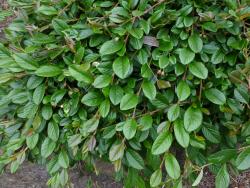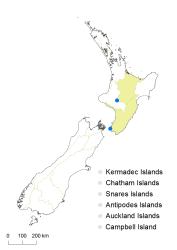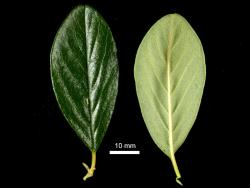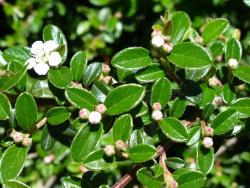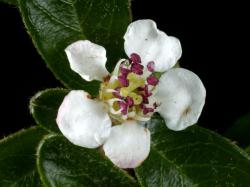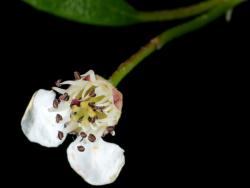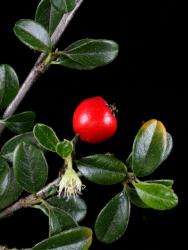Prostrate shrub 15 cm tall, evergreen. Branches not in planes; branchlets red-brown, lenticels present, branchlet hairs sparse to moderately dense; stipule 2.3–6.0 mm long, green, sparse, white. Leaves crowded on branches, 27–60 mm long, lamina 23–51 mm long, 13–27 mm wide, elliptic to obovate, plane to slightly V-shaped, texture thick (230–320 µm), petiole 3–11 mm long, hairs sparse to moderately dense, leaf base cuneate; apex obtuse, sometimes appearing emarginate, apiculus bent downwards; lateral veins in 5–8 pairs, midvein and lateral veins impressed above and projecting below; upper surface smooth or slightly rugose, mid to dark green, semi-glossy, upper-surface hairs absent or sparse when young; margins plane or recurved, hairs moderately dense; lower surface glaucous, hairs sparse to moderately dense.
Inflorescence of 1–2 flowers, 40–65 mm long with 2–4 leaves, rachis hairs sparse, white; pedicel 3.0–23 mm long, hairs sparse to dense. Flowers 10.0–12.2 mm diameter. Hypanthium green, sepals 1.0–1.5 mm long, 2.1–2.5 mm wide, hairs sparse to moderately dense. Petals pink in bud, white and spreading when open, 3.8–4.1 mm long, 3.8–4.6 mm wide, base clawed, tuft of hairs absent, margins entire, minutely papillose. Stamens 21–25; filaments 2.8–3.6 mm long, white, pink before flower opening; anthers dark pink, 0.9–1.1 mm long; styles (4)5, 3.7–4.0 mm long. Fruit vivid red, spherical to obovoid, 5.3–8 mm long, 6.5–7.8 mm diameter, calyx closed, glabrous except at calyx. Pyrenes (4)5, 3.5–4.3 mm long, 2.5–2.6 mm wide, hairs moderately dense at apex, style attached at pyrene apex or up to 0.7 mm below apex.
A prostrate or cascading shrub. Branchlets glossy red-brown with lenticels. Flowers solitary or paired. Pedicels may be very long (up to 23 mm long). Petals pink in bud, white and spreading when open. Stamens 21–25, filaments white, anthers dark pink. Leaves medium-sized (lamina 24–37 mm long), midvein and lateral veins impressed, semi-glossy on upper surface, glaucous with moderately dense, fine hairs below. Fruit vivid red, pyrenes (4)5 per fruit, style attachment at or near to apex. At Christchurch Botanic Gardens growing as an erect, standard plant, possibly grafted onto an erect-growing species.
Most similar to Cotoneaster ×suecicus, a hybrid that has C. dammeri as one of its parents. Both have a prostrate or cascading form. Both have leaves glaucous beneath with fine hairs that are not persistent, and both have white, spreading petals. They differ in leaf size: in C. dammeri the lamina is 23–51 mm long, 13–27 mm wide (cf. 15–27 × 7.2–15 mm in C. ×suecicus), the leaf lateral veins are impressed in C. dammeri but not in C. ×suecicus; in C. dammeri there are (4)5 pyrenes per fruit (cf. 2–4(5) in C. ×suecicus). Cotoneaster dammeri has pedicels that are sometimes very long (3.0–23 mm), while in C. ×suecicus they are 1.5–10 mm long.
Volcanic Plateau (Raetihi), Southern North Island (Wellington—Khandallah). Known in cultivation in Whangārei and Christchurch, but probably in many other places.
C.C. Ogle, Raetihi camping ground, 2 July 2004, CHR 570614A–C. The identity of the plant is uncertain: whether it is Cotoneaster dammeri or C. ×suecicus. CHR 570614, collected in July 2004, has 4–5 pyrenes per fruit, while CHR 536439, collected from the same plant in January 2000, has (2)3(4) pyrenes per fruit.
Flowering: (September) November to February; Fruiting: January to July, persisting over winter
Diploid (Fryer & Hylmö 2009, p. 136), confirmed by flow cytometry results using CHR 635247 and CHR 637386.



